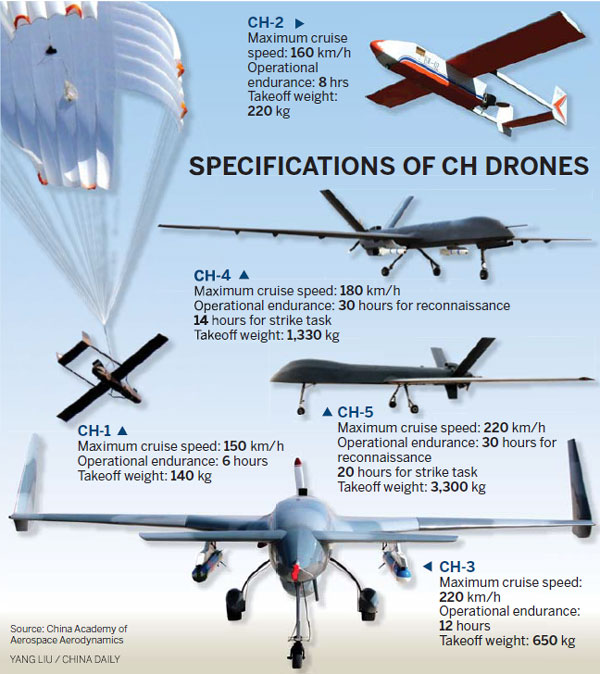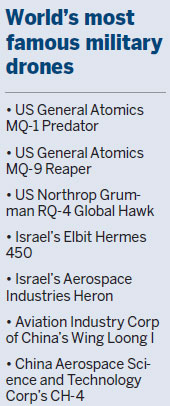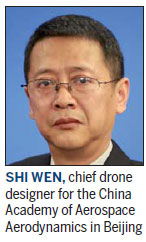Militaries zero in on CH
Updated: 2016-04-29 08:26
By Zhao Lei(China Daily Europe)
|
|||||||||
Series attracts overseas buyers searching for 'powerful, affordable' models, says top designer
A number of foreign nations are awaiting delivery of CH military drones, one of China's most popular products on the international arms market.
The series, called Cai Hong, which translates as rainbow, is considered by experts to be among the most lethal. The newest and largest capacity combat drone in the series, the CH-5, is awaiting government approval for export.

"The total value of the contracts we signed last year could definitely be one of the highest on the international market," says Shi Wen, chief drone designer for the China Academy of Aerospace Aerodynamics in Beijing. He did not reveal an exact figure.

The academy, part of China Aerospace Science and Technology Corp, is one of the country's largest military drone developers. Its CH drones have been sold to more than 10 countries, and are the largest military drone family that China has exported, Shi says.
The early models, CH-1 and CH-2, are small, unarmed reconnaissance craft that have a proven record in locating and monitoring targets, he says, adding that the CH-3, a larger midrange combat and reconnaissance drone, and the CH-4, a mid-altitude and high-endurance armed drone, have attracted buyers seeking powerful, affordable unmanned combat aircraft.
"Our best-seller so far is the CH-3, but the CH-4 has also received many orders," Shi says.
He declined to disclose which countries have purchased the series, revealing only that the academy's most valuable sale was worth hundreds of millions of US dollars.
China Space News reported in January last year that the academy would deliver about 200 CH drones to domestic and foreign users. Western media also cited Egypt, Saudi Arabia, Pakistan, Nigeria and the United Arab Emirates as buyers.
The first contract to export CH models was signed in 2003 and fulfilled in 2004, when a South Asian country bought several CH-1s, Shi says. Since then, the buyer has become a loyal user and is negotiating the purchase of some CH-4s, he adds.
"Foreign militaries have bought our products because our drones have strong capabilities and are easy to use. If you can play flight simulation games, then you can use our drones. Also, we understand what users really need."
Compared with competitors, the CH drones can carry more weapons and have a higher level of automation, so only a small number of ground controllers are needed, Shi says.
He explains that his designers researched the requirements of potential users and decided their military drones should operate at an altitude above 5,000 meters.
"We believe most of our users will use the drones to patrol borders, reconnoiter targets and hit terrorists or insurgents, who usually have small antiaircraft weapons capable of striking planes about 3,000 meters off the ground. The 5,000-meter altitude is high enough to ensure the safety of our drones."

The CH-3 and CH-4 models are capable of firing missiles from a distance of about 10 kilometers to a target and can stay in the air for more than 10 hours, Shi says.
"The CH-3 has a designed operational span of 5,000 hours. It's very good at long-duration, continual operation. One of our clients in Africa uses each of its CH-3s for about 100 hours on average each month. It once used a CH-3 for about 300 hours in a single month and the drone had no problem at all."
The latest and heaviest drone in the family, the CH-5, has attracted keen interest from foreign clients since its maiden flight in August, Shi says. The model is made of composite materials and has a wingspan of 21 meters. It can stay in the air for up to 30 hours and operate at an altitude of up to 5 km. It can fly at speeds ranging from 160 to 220 km/h and operate 2,000 km from ground control if connected via satellite.
While previous armed drones typically had a maximum takeoff weight of less than 1,500 kilograms, the CH-5 is able to fly with a weight of 3,300 kg, according to the academy's specifications.
The larger capacity enables the drone to have more reconnaissance devices, so it can detect a given target within an 80 km radius, says Lan Wenbo, a chief engineer.
Shi adds that the CH-5 is capable of launching various air-to-surface missiles and laser-guided bombs, and can conduct early-warning operations after an upgrade.
zhaolei@chinadaily.com.cn
Related Stories
PLA restructuring changes focus at military schools 2016-04-28 02:06
Ministry: Military will safeguard state sovereignty and security 2016-04-25 22:13
Xi stresses joint battle command for military reform 2016-04-21 00:02
Airplane- enthusiast farmer builds 'military helicopter' 2016-03-28 14:08
Today's Top News
Running the world
Getting back to basics
Alibaba denies reported takeover of AC Milan
China stresses Putin's expected visit
Russia launches rocket from Vostochny Cosmodrome
Record number of Chinese exhibitors at Spanish expo
Beijing least affordable city in the world to rent
US accused of 'hyping up' military flights
Hot Topics
Lunar probe , China growth forecasts, Emission rules get tougher, China seen through 'colored lens', International board,
Editor's Picks

|

|

|

|

|

|







